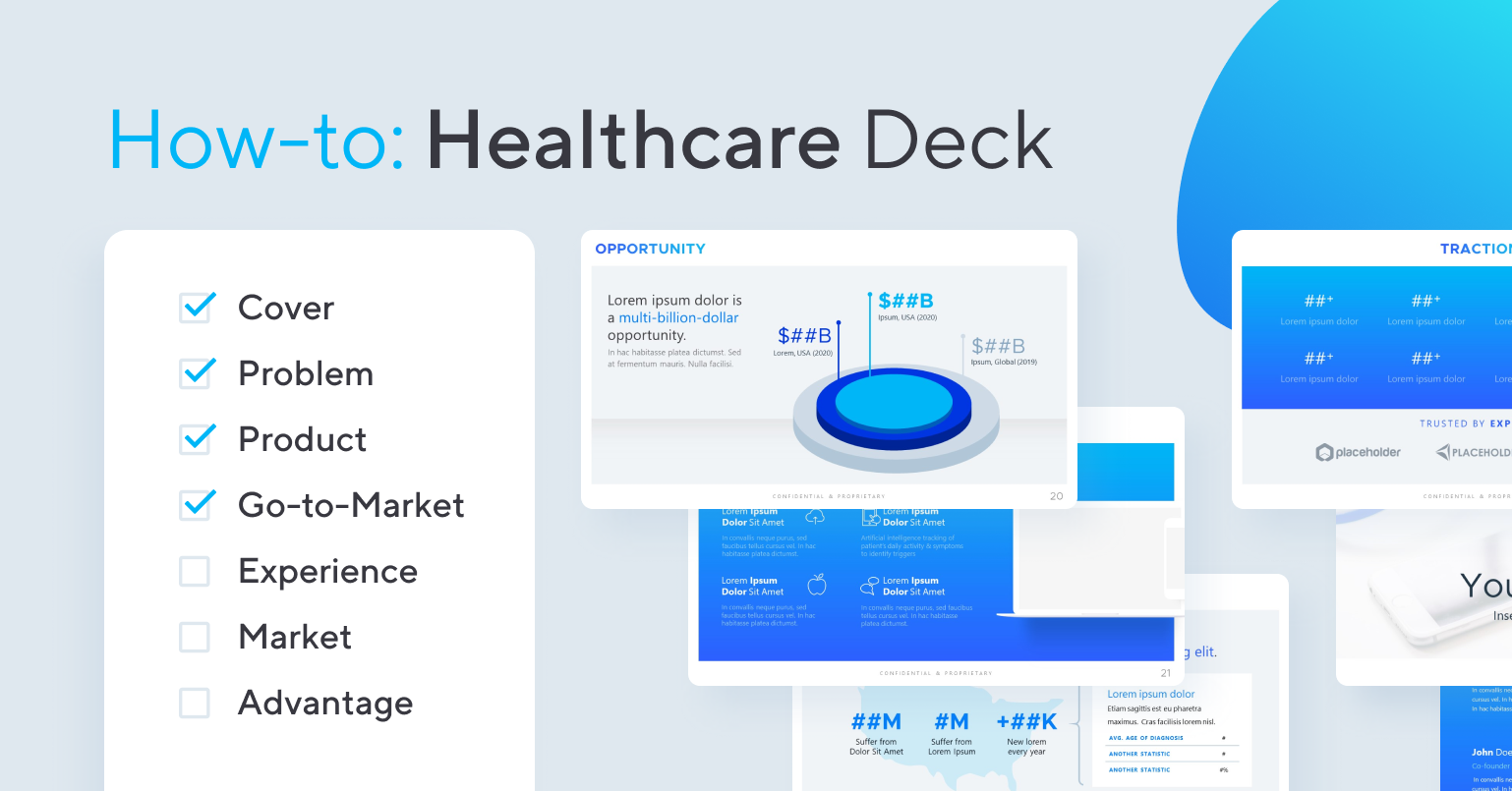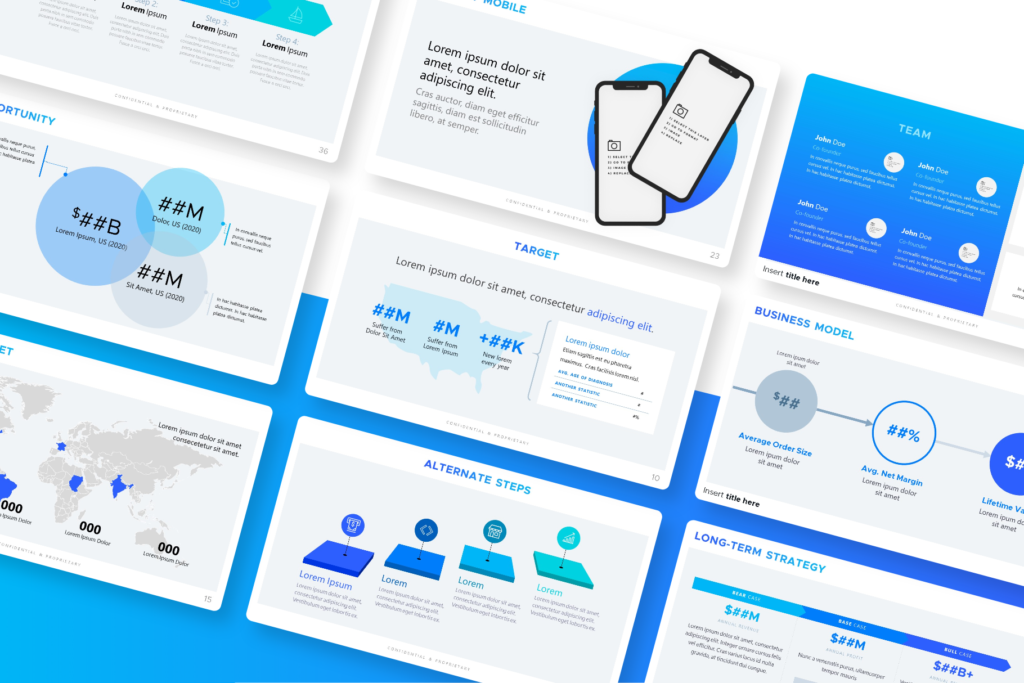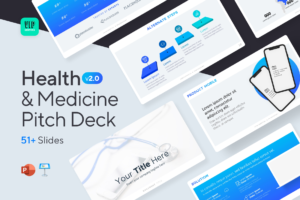Healthcare is usually one of the biggest sectors in any given economy. In 2019, the U.S. spent $3.8trillion on healthcare, the Centers for Medicare & Medicaid Services reported. That’s an increase of 4.6% from 2018. It is also the fastest-growing industry in the US, estimated to grow 19% between now and 2024.
With this size and growth, comes great opportunities for innovation, modernization, and of course, competition. If you are about to create a Healthcare Pitch Deck and wondering how to go about it; how to beat your competition, and how to make the prospective investors jump on your brilliant idea’s bandwagon, we are here to help!
Using our clout of creating hundreds of pitch decks and securing millions of dollars in funding, we will give you a step-by-step temple to create a pitch deck that will close deals.
What slides should you include in your Healthcare pitch deck?
Most pitch decks (Healthcare or otherwise) require a minimum of 10 – 15 slides. Always ensure to make the slides very simple and straight to the point because bulky and unnecessary information can bore your investors.
-
Introduction Slide
The purpose of this slide is to introduce your startup or company to potential investors. This slide usually includes a logo, goal, and tagline. Be mindful of the company branding when creating the introduction slide.
-
Problem Slide
It is important that you present the problem in such a simple and concise way investors can understand and relate to it. It is also important that you are focusing on one issue and solve one problem.
Problems in the medical sector can be very technical. If necessary, you can have multiple slides to explain the issue.
-
Solution Slide
This slide will describe your solution to the said problem. If people attending the presentation are active in the healthcare sector such as doctors, they’d be very interested in the solution, and you have to make sure you don’t overpromise. Keep it straightforward, simple, and uncomplicated.
-
Regulation Slide
The Healthcare sector is highly regulated. If your product, service, or idea needs to pass or has passed any regulation, you can mention that here.
This is important because the investors will likely include people with technical expertise. They will call you out on your timeline if you haven’t gotten approval from the relevant authorities.
On the other hand, if you have gotten the necessary approval, this will be a big help in your goal to secure funding. Even if this doesn’t apply to your product or service, you can still mention it as this will show that you have covered every corner.
-
Market & Competition Slide
No company can survive if there is no market to sell products to. Market size, growth, and demographics are very important for the investors and you will present the relevant information here.
You want to make sure that you are presenting the market data related to your product or service. Your goal is to convince the investors that the current market is the best time to invest in your company.
The market slide will also cover your competition. According to a study, competitors are a top priority for investors. They are interested in knowing how are you different and preferably better than your competition, and how you are going to beat the competition and capture the market.
-
Business Model Slide
Your business model will answer a very important question from the investor’s perspective: How will you earn profit?
Depending on the circumstances, your business model can be a one-time product, printer and cartridge business model, subscription-based service, or something the likes of which the world has never seen. Make sure the audience understands your model and the reasoning behind that model.
-
In-action Slide
If your product or service is already in use, it’s a very good idea to show it off to establish authority and trust. Let’s imagine you have invented a device that can cure x disease better than the traditional procedures; you should include the results, graphs, and data in this slide.
If your company has a large following or notable partners, that can be shown here too.
-
Growth Slide
Only include this slide if your startup or company has growth to show; for example, month-on-month revenue or subscription growth. However, only show this slide if you have something solid to show for. To give you an idea, accelerator programs like Y Combinator expect at least 15% month-over-month growth.
-
Team Slide
Team Slide is often overlooked but it is one of the most important slides. Investors want to know the people at the helm and if they are capable of actually making this work. (e.g. see WeWork CEO, founder Adam Neumann for a startup failing because of the leadership)
In this slide, you can include details about the leadership and list some of their achievements. Keep it simple and believable. The last thing you want to do is come off as unreliable.
-
Finance Slide
After the competition and the team, finance is the most important thing for the investors. You want to paint a picture of finances for the next 3 to 5 years. Although no one can predict the future, this estimate can give the investor an idea of where the company is heading.
You want to be conservative with your estimates and not overpromise. Finance is a really sensitive issue and you should be completely transparent and straightforward with it. You may also want to have details of your financials with you. Interested investors might want to take a deeper look than the pitch deck.
-
Call to Action
A clear call to action is very important from your perspective because the whole point of the deck is to make them invest in your idea.
Don’t ask for a fixed number but give a round figure, for example, instead of $5 million, you can ask for $3 to $6 million. If the investment company has a smaller budget, it will still be able to accommodate you.
-
Closing Slide
In the closing slide, you will cover your contact details and the “next steps” section. If you or the leadership team happens to have a huge social media following, this is the place to show it off and let investors know you are the real deal.
What key topics should a Healthcare Pitch Deck address?
Below are the questions every healthcare deck should answer:
- Who is interested in your healthcare product or service?
- What makes your healthcare product or service unique?
- What is your pricing and profit model?
- What traction or experience have you achieved?
- How do you acquire customers for your business?
- What investment (or deal) are you looking for? Why?
- What are your goals & key milestones? What are you going to achieve?
Designing a healthcare pitch deck? Check this out:
You might be interested in the popular Healthcare Pitch Deck Template designed by our team at VIP.graphics: cutting-edge slides based on decks that closed millions in deals & investments for orgs of all sizes: from high-growth startups to Fortune 100 corporations. Super simple to customize in PowerPoint or Keynote, this template offers you ready-made elements & all the essential slides to help your business stand out: it’s a matter of minutes to create and share this convincing & professional deck with your stakeholders & investors — learn more here.


